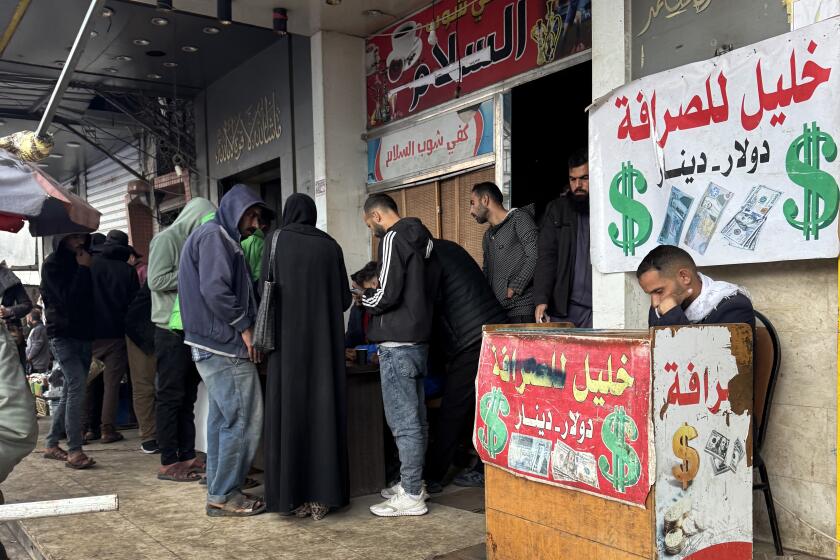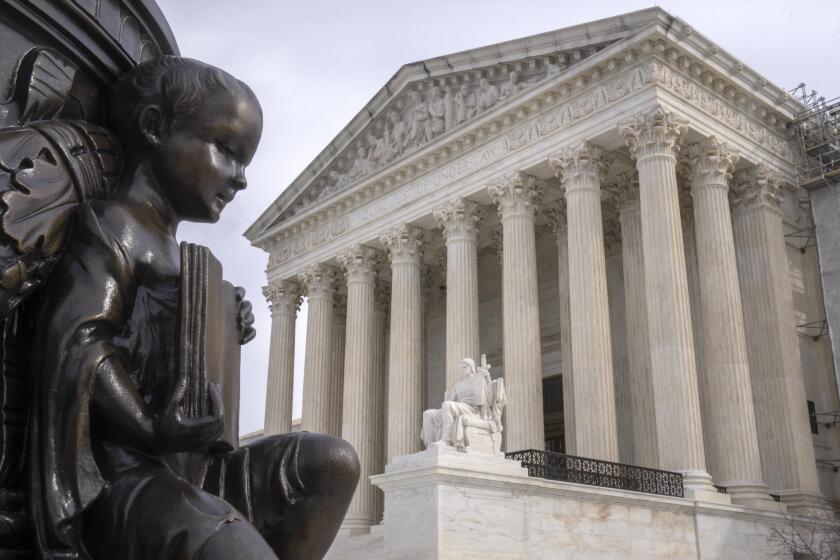Iran says it conducted space launch in a program criticized by West; nuclear watchdog adds warning

- Share via
MANAMA, Bahrain — Iran is poised to “quite dramatically” increase its stockpile of near-weapons-grade uranium as it has started cascades of advanced centrifuges, the head of the International Atomic Energy Agency warned.
The comments from Rafael Mariano Grossi came just hours after Iran said Friday it conducted a successful space launch with its heaviest payload ever, the latest for its program the West alleges improves Tehran’s ballistic missile program.
The launch of the Simorgh rocket comes as Iran’s nuclear program now enriches uranium at 60%, a short, technical step from weapons-grade levels of 90%. Iran maintains that its program is peaceful, but officials in the Islamic Republic increasingly threaten to potentially seek an atomic bomb and an intercontinental ballistic missile that would allow Tehran to use the weapon against distant foes like the United States.
The moves are likely to further raise tensions gripping the Middle East over Israel’s continued war on Hamas in the Gaza Strip and as an uneasy cease-fire holds in Lebanon.
However, Iran may as well be preparing the ground for possible talks with the incoming administration of President-elect Donald Trump, who in his first term unilaterally withdrew the U.S. from Tehran’s nuclear deal with world powers.
The cease-fire between Israel and Hezbollah ended the deadliest bout of violence between the two sides in decades.
Grossi, speaking to journalists in Bahrain on the sidelines of the International Institute of Strategic Studies’ Manama Dialogue, said his inspectors planned to see just how many centrifuges Iran would be spinning after Tehran informed his agency of its plans.
“I think it is very concerning,” Grossi said. “They were preparing and they have all of these facilities sort of in abeyance, and now they are activating that. So we are going to see.”
He added: “If they really make them turn — all of them — it’s going to be a huge jump.”
A statement the International Atomic Energy Agency, or IAEA, issued shortly after Grossi’s remarks said Iran had begun feeding two cascades of advanced IR-6 centrifuges with uranium previously enriched up to 20% at its underground Fordo facility. That site is under a mountain, protecting it from airstrikes.
Cascades are a group of centrifuges that spin uranium gas together to more quickly enrich the uranium. The IR-6 centrifuges enrich uranium faster than Iran’s baseline IR-1 centrifuges, which have been the workhorse of the country’s atomic program. Adding 20% uranium, as opposed to 5% uranium previously planned, further speeds up that process.
No banks. No bills. Israel’s blockade on cash imports into Gaza leaves Palestinians there with disintegrating paper money amid growing desperation.
“The facility’s updated design information showed that the effect of this change would be to significantly increase the rate of production,” the IAEA statement said. Iran separately will start feeding natural uranium into eight other IR-6 cascades at Fordo as well to produce 5%-enriched uranium, it added.
The IAEA warned in late November that Iran was preparing to begin enriching uranium with thousands of advanced centrifuges. That came as a response to the Board of Governors at the IAEA condemning Iran for failing to cooperate fully with the agency.
Iran did not immediately acknowledge the preparations. The Iranian mission to the United Nations did not respond to a request for comment.
Meanwhile, Friday’s launch took place at Iran’s Imam Khomeini Spaceport, the site of Iran’s civilian space program, in rural Semnan province about 135 miles east of Tehran.
The Simorgh carried what Iran described as an “orbital propulsion system,” as well as two research systems into orbit above Earth. A system that could change the orbit of a spacecraft would allow Iran to geo-synchronize the orbits of its satellites, a capability Tehran has long sought.
It also carried the Fakhr-1 satellite for Iran’s military, the first time Iran’s civilian program is known to have carried a military payload.
Iran put the payload of the Simorgh at 660 pounds, heavier than any of its previous successful launches within the country. State television carried video of a correspondent discussing the payload just as the Simorgh lifted off into the sky, as people called out: “God is the greatest!”
The U.S. military referred questions about the launch to the country’s Space Command, which did not respond. Space experts said tracking data appeared to show the launch successfully put objects in orbit.
The United States has previously said Iran’s satellite launches defy a United Nations Security Council resolution and called on Tehran to undertake no activity involving ballistic missiles capable of delivering nuclear weapons. U.N. sanctions related to Iran’s ballistic missile program expired in October 2023.
“Iran’s work on space-launch vehicles — including its Simorgh — probably would shorten the timeline to produce an intercontinental ballistic missile, if it decided to develop one, because the systems use similar technologies,” a U.S. intelligence community report released in July said.
Iran has always denied seeking nuclear weapons and says its space program, like its nuclear activities, is for purely civilian purposes. However, U.S. intelligence agencies and the IAEA say Iran had an organized military nuclear program until 2003.
Under Iran’s relatively moderate former President Hassan Rouhani, the Islamic Republic slowed its space program for fear of raising tensions with the West. The late hard-line President Ebrahim Raisi, a protege of Supreme Leader Ayatollah Ali Khamenei who came to power in 2021, pushed the program forward. Raisi died in a helicopter crash in May.
Iran’s reformist President Masoud Pezeshkian, who has been signaling he wants to negotiate with the West over sanctions, has yet to offer a strategy when it comes to his nation’s ambitions in space. The Simorgh launch represented the first for his administration from the country’s civil space program. Iran’s paramilitary Islamic Revolutionary Guard Corps conducted a successful launch in its parallel program in September.
Gambrell writes for the Associated Press. AP writer Nasser Karimi in Tehran contributed to this report.
More to Read
Sign up for Essential California
The most important California stories and recommendations in your inbox every morning.
You may occasionally receive promotional content from the Los Angeles Times.












